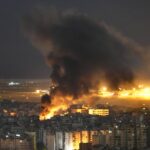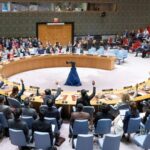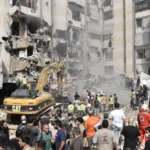KABUL – Three children sit stunned on the roof of a mosque in Baghlan province, northern Afghanistan, their eyes covered with mud covering their entire bodies.
Beside them, a rescuer lowers their two-year-old baby brother, Arian, to the surface, a sheet tied around his waist that was used to pull him from the raging flood waters below.
The rescuer says in the video: “Take her, let’s remove the rope from his body.” “Bring his mother to hold him in her arms and keep him warm.
In the past few days, at least 300 people have been killed in floods in 18 districts across at least three provinces in northern Afghanistan, according to the United Nations World Food Programme, and at least 200 others have been injured.
Videos show raging torrents of mud sweeping away mud houses – and people, limbs flying, in the fast-moving brown current as rescuers watch from high ground, out of reach.
The rescued children, ages 3, 5, and 6, were among eight siblings at home with their parents in Follo, in the Bulka district of Baghlan, when the floods struck.
Their uncle Barakatullah, the son of Hajj Wakil Bismillah, the local school’s principal, said that something ominous seemed to be brewing late last week when strong winds swept through the area and neighboring areas, shrouding everything in darkness.
Visibility was so bad that we couldn’t even see each other,” he said.
He added that the rain began to fall gently during Friday prayers, an unusual event for residents, who say that rain does not often fall heavily in the mountainous region, which about 10,000 people inhabit.
As the rain increased, the situation suddenly became “tragic.”
People fled to higher ground, seeking refuge in the mountains and hills. Unfortunately, some individuals who could not leave their homes fell victim to the floodwaters.
Aerial photos show possessions piled up in plastic bags on rooftops, including statues of masked women forced to cover their entire bodies even in times of disaster.
The rescued women are forced to wear mud-soaked clothes, while even infants between two and three months wear similar dirty clothes,” Barkatullah said. He added that more than 100 people were believed to have been killed in Follo, most of them women and children.
Some burials began over the weekend, but many are already believed to be buried deep under mud. Afghan relatives pray during a burial ceremony for flood victims in Baghlan. According to Timothy Anderson, head of the World Food Program in Afghanistan, animals and farmland have been swept away by the torrent in a region already facing severe food shortages.
He said flood-hit areas were already vulnerable to famine after a difficult summer when extreme heat caused drought. It was bleak. “Now it’s catastrophic,” he said.
He said residents expect to see flash floods most of the year, but they were much worse this year. Anderson said the loss of homes and land had a devastating impact on survivors, who were already among the poorest people in the country.
When people lose a few livestock, that is their livelihood,” he said.
Floodwaters cut off roads leading to the worst-hit areas, forcing the World Food Program to use donkeys to send supplies.
On the first day, WFP distributed high-energy biscuits and food to children. They also support local bakeries by providing free bread. In the coming days, teams will begin distributing food to feed families for a month—what will happen after that is unclear.
Anderson said that 17 joint assessment teams and other partners have been sent to the region. He said it would take teams four or five days to properly examine the floods’ impact on people, their housing, and infrastructure.
This latest natural disaster follows a drought in Afghanistan and is seen as an example of the climate crisis hitting those who have contributed least to rising global temperatures.
They don’t emit carbon emissions,” said the World Food Programme’s Anderson. This is a community and a subsistence farming community. So, they bear the brunt of that without contributing significantly.
He said that during the recent drought, efforts were made to help the community capture rainwater in dams and irrigation canals to preserve crops. Now, those efforts have dissipated, posing another challenge.
The need is enormous, and not just in Afghanistan. Anderson said the world is seeing the impacts of more significant, more severe events, drought or rain-fed hurricanes.
In a statement issued on Sunday, Teresa Anderson, head of global climate justice at ActionAid International, said, “The climate crisis continues to rear its ugly head. With the latest incident, Afghanistan joins a long list of countries in the Global South suffering from floods this year.”















